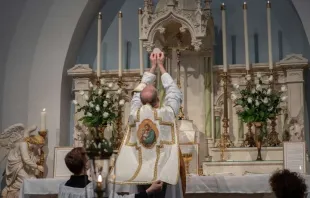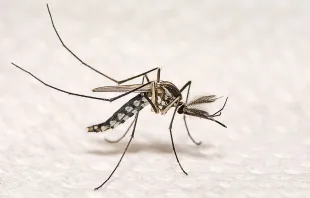Articles by Dr. Grazie Pozo Christie
The Mass is 'essential'
Sep 1, 2020 / 00:00 amIf American Catholics feel singled out in this strange year they are not being paranoid, they are simply paying attention. From church burnings to the verbal and physical abuse heaped on beloved saints and their statues, the incidents have piled up. And, on top of all this, local jurisdictions have too often piled on by categorizing the mass – the source and summit of Catholic life – as “non-essential.” In the city of San Francisco, social indoor gatherings have been indefinitely prohibited since a June spike in COVID-19 cases. Movie theaters, nightclubs, indoor entertainment complexes are all shuttered. Outdoor gatherings are limited to 12 people, and participants must wear masks, keep six feet apart and not share food or implements. This effectively rules out team sports and other pleasant activities the city deems non-essential. But it also rules out indoor masses and outdoor masses with more than ten mass-goers, because local officials put religious observances in the same class as baseball games. Some Church prelates, notably Archbishop Cordileone of San Francisco, are reacting not with anger but with gentle persistence and ingenuity. The Church in San Francisco has pleaded with local officials to be allowed to hold indoor masses while employing strict safety measures, as is being done in many parts of the country and, indeed, other parts of California. Dioceses are using highly detailed guidelines that the Thomistic Institute developed for bishops. These guidelines are based on the advice of scientists, doctors, infectious disease experts, and theologians who have applied current Centers for Disease Control and World Health Organization standards to worship. As a result, Catholic churches across the United States are meticulously doing the right thing: cordoning-off pews, spacing family groups, enforcing mask-wearing, refraining from singing and handshaking. The whole mass experience has changed dramatically, thanks to the seriousness, respect, and mutual care of American Catholics. Going to mass these days may well be among the safest outings a family makes all week. In fact, a recent study of over one million public masses celebrated under strict guidelines in the U.S., shows no outbreaks linked to church attendance or evidence of viral transmission. And yet indoor mass under these science-based guidelines is prohibited in San Francisco—and limiting outdoor masses to 12 participants makes it impossible for any but a tiny portion of the Catholic population to go to mass. Archbishop Cordileone has made a moving video plea explaining the importance of gathering together for worship. More than that, he has demonstrated the essential nature of the sacraments by organizing a long day of multiple small masses in the Cathedral plaza on the feast day of the Assumption. Spaced out in groups of 12, the San Francisco faithful knelt and stood and prayed - apart but mercifully together. These are the kinds of signals that local governments need to heed when contemplating or enforcing shutdowns that fail to recognize the essential nature of worship. Lockdowns have caused an explosion of existential loneliness as adults and children are isolated from extended family, friends, co-workers. They’re cut off from even simple daily contacts with pleasant strangers or acquaintances. Rising suicide and overdose rates are a heartrending testament to this cold social fact. For millions of Americans, the church “family” is one of their main connections to others, through daily or weekly mass. For those same Americans, being unable to receive the sacraments, the physical expression of communion with God, is a spiritual tragedy. Perhaps worse still, the inability to hold a funeral mass for a cherished husband or child is grief piled upon aching grief on the bowed shoulders of the bereaved. And where’s the fairness in all this when a dizzying array of other kinds of gatherings are being classed as “essential” or excused? In San Francisco, the list of exceptions to shutdown is long. Retail storefronts can remain open as long as staff and shoppers stay six feet apart and do not exceed half normal occupancy. Factories, warehouses and logistics businesses can operate if everyone inside can remain six feet apart. Grocery stores, banks, airlines, childcare centers and summer camps – all are open. Political demonstrators are allowed to throng city streets by the packed thousands. It is safe and fair to classify religious observance as essential – because it is. Archbishop Cordileone of San Francisco won’t be the last prelate to gently and insistently work around the current restrictions that unfairly target religious Americans.
Lessons learned during past pandemics - from a Catholic perspective
May 5, 2020 / 00:00 amCoronavirus is only the latest iteration of an age-old human affliction. Even now, with the benefit of advanced medical science, our reaction – our confusion, our fear – is not so different from how our ancestors experienced recurrent and terrifying onslaughts of plague, cholera, and yellow fever across the ages. We can learn from the courage and ingenuity of those who travelled this road before us. Consider the work of Dr. Carlos Finlay in Cuba. In 1880 he hypothesized, and then worked to prove his hypothesis, that yellow fever, a disease that regularly decimated coastal populations up and down the Americas, was spread by infected mosquitos. Those mosquitos came to our shores in the 17th century on African slave ships and attacked portal communities in the tropics as well as cities like New Orleans and Philadelphia. The resulting epidemics occurred with oppressive regularity in the summer months, to the people’s great dread, with mortality rates as high as 50 percent. The impact was tremendous – not only in the milllions of lives lost and the wretchedness this caused, but in economic gains and opportunities wiped out or delayed (the Panama Canal). Connecting the transmission of the deadly virus to its source or vector was a decisive step forward in the long struggle against yellow fever. It preceded the development of a vaccine by more than 60 years. Here's how it happened: A young doctor, Carlos Finlay, returned to his home in Havana one night, exhausted, after caring for a Carmelite priest dying of yellow fever. Realizing he had forgotten to say his daily rosary, he sat in his armchair, sweating in the oppressive heat, fingering his beads and swatting at a bothersome mosquito. Suddenly, inspiration pierced his depression and weariness: Could the mosquito, like the one annoying him that moment, be transmitting the infection from person to person? If so, this was marvelous. One could not fight the brutal steamy summer air – the miasma – but one could fight mosquitos. Inspiration, however, was not enough to proceed. Courage and even heroism would be needed to prove Finlay’s hypothesis. These were at hand, thanks to 57 young Jesuit priests and brothers who volunteered as experimental subjects. As each arrived from Spain to staff the Colegio de Belen, newly founded by Queen Isabel II of Spain, he was met by Finlay, carrying a test tube filled with mosquitos that had just fed on a patient sick with yellow fever. Taking their lives in their hands, these Jesuits allowed themselves to be bitten for the sake of their fellow human beings. Three died of the bite, but all 57 were willing to do the same. Subsequent experiments supported Finlay’s hypothesis. Although a vaccine to definitively eradicate the disease would not come for decades, Finlay’s insight helped man to co-exist safely with yellow fever until that time. The incidence of yellow fever in Cuba dropped precipitously through mosquito control. Standing water, a breeding ground for the noxious pests, was eliminated where possible or treated aggressively with insecticides where not. Panama, where tens of thousands of workers had already died of the disease while building the canal followed Cuba’s lead. The last Panama Canal worker to die of yellow fever came in 1906. There are important lessons for us here -- first and foremost, lessons in resourcefulness and valor. Already, thousands of human minds are, today, tenaciously working to find a solution to Covid-19. They’re persisting without respite, persisting through depression and fatigue, to find a way forward. Just as Dr. Finlay did. And, you can depend on it, inspiration is sure to strike again. You can also see today the same kind of valor that animated the Jesuit volunteers who let the infected mosquitos bite them. You see it in the countless men and women who keep showing up for work at nursing homes or crowded food production lines. Their examples help us all to keep up and increase our courage so we can join them as we ease back into our normal daily lives. As we face the moment when we too realize that we have no choice but to go back out into the world of work and personal interactions, we can take hope from contemplating our predecessors’ success in confronting yellow fever. Like us, they dreamed of a vaccine. But they didn’t lock themselves away until it was developed. They found a way to steel themselves and then to steal the deadly efficiency away from the virus that plagued them. A century later, we can do the same.
Mother Teresa: An intercessor for the persecuted charitable works of the Church
Sep 4, 2017 / 00:00 amThe canonization of Mother Teresa a year ago by Pope Francis was a momentous occasion for Catholics. Every newly-made saint’s brand of holiness teaches us vivid things about love and God which are distinctive and unique. The small, spare woman in the iconic white sari serves as a potent symbol of the indispensability of the Church. St. Teresa of Calcutta is a glowing reminder that millions of the world’s poor and vulnerable depend on the immense good that the Church does as she goes quietly about her daily business. To impede her mission or persecute her is to hurt those who rely on her for assistance. Like many saints, St. Teresa’s path to holiness and canonization was rich in improbability. In 1946, the little Albanian nun was nothing but a humble teacher in India when she received her “call within a call.” She heard a quiet, internal suggestion to help the poorest of the poor while living among them. In an act of almost terrifying audacity, she made her way (with five rupees in her pocket) to what was probably the most rank and dire slum in the world to serve the destitute and abandoned. That was in 1948. Today, the religious congregation she founded consists of thousands of sisters and is active in over a hundred countries. They run hospices for people with leprosy, AIDS, and tuberculosis. They run soup kitchens, mobile clinics, dispensaries, and orphanages, all for free, while living their vows of poverty and chastity. The Missionaries of Charity seem to shine with holiness as they go cheerfully about their heavy work, instantly recognizable the world over. But they are only one small part of the vast enterprise that is the Catholic Church’s charitable mission. Wherever there is war, famine, disease, ignorance, homelessness, there the Church goes to work, helping more effectively and tenderly than secular NGOs and government programs ever could. In sheer numbers of people fed, elderly and dying housed, lepers attended, AIDS sufferers succored, children educated, and sick cared for, the Church is hands down the largest charitable organization in the world. This is not a coincidence. The Church boasts luminaries like Mother Teresa because for more than 2,000 years, the Church has believed and taught that Jesus meant what he said: “Whatsoever you do to the least of my people, that you do unto me.” To alleviate the suffering of others is a duty of each and every member of the Church. Some, like Mother Teresa, took this duty and rose to dizzying heights. Others are inspired to volunteer for the St. Vincent de Paul society or to lend a hand at the parish nursery school where migrant workers leave their babies as they head off to a hot day in the field. This charitable concern for the world’s poor and suffering has been a mission constantly exercised by the Church along with communicating a message based on the same Gospel teaching of radical equality and brotherhood that inspires her charitable mission. This leads to the conviction that respect for human dignity must be absolute. Therefore, abortion, euthanasia, and assisted suicide, all ways in which materialism offers death as a reasonable response to human suffering or inconvenience, must be firmly rejected. Firm adherence to classic Christian teachings leads many to object to her with indignation. The critics of the Church recklessly go about their business with little thought for all those who depend on her. The ACLU gnaws constantly at her sides, demanding she get out of the hospital and clinic business and stop helping the unaccompanied children at the border because abortions are not offered. The Little Sisters of the Poor are still waiting for relief from the Obamacare contraception and abortifacient mandate which threatens them with huge fines for noncompliance. Despite the millions spent by the Church on legal fees and defensive measures, there remains a very real possibility that charities all over the country will be shut down. Catholics believe that saints in heaven not only take a lively interest in the world today, but that they can also intercede for us and help us in our struggles. If this is true, St. Teresa of Calcutta is likely loving the poor and marginalized even more ardently than she did when she could touch them with her hands. Surely she is hard at work at softening the hearts of those who oppose the Church and seek to shut her down. St. Teresa will not cease to help those who need her, and if her image of perfect goodness can generate sympathy for the Church and her ways, she will have achieved another miracle.
Book review - "Strangers in a Strange Land"
May 21, 2017 / 00:00 amWoven into the fabric of American society, present in every milieu, and taking some part in all the complicated ways we relate to each other in public and private settings are over 70 million American Catholics. We mirror the demographic changes of the general population, and are the largest religious denomination in the country. And yet, there are many of us who feel exactly like the title of Archbishop Chaput’s new book: Strangers in a Strange Land. We are clearly living in a culture that is very different from that of the past, and one becoming quickly more different. Archbishop Chaput does a masterful job in the first part of the book explaining how the culture shifted. As he writes in his introduction: “People who hold a classic understanding of sexuality, marriage, and family have gone in just twenty years from pillars of mainstream conviction to the media equivalent of racists and bigots.” He goes on, in his lucid and measured prose, to explain just how we found ourselves here – in this strange land – and what we are supposed to do now. The classic Western view of marriage as between one man and one woman, faithful, permanent and exclusive, was, up until only recently, the general and normative view. It is based on the Christian belief that men and women have equal personal dignity and they each deserve a love that is unique and exclusive. Now we are seeing even polygamy being presented to us as yet another co-equal and dignified arrangement between consenting adults. For example, a recent episode of Say Yes to the Dress showcased a polygamous union, as a throuple got married: two women in white walking down the aisle to the groom. This scenario was presented as based on generosity and kindness, as the old wife no longer wants physical intimacy with her husband but doesn’t want him to be “lonely.” They all seemed very pleased with their arrangement, open minded, and sympathetic. How long before it’s considered bigotry to call these unions wrong? And how long after that will those of us who can’t participate – in good conscience – through our small business health plans, adoption agencies, parish ministries, and wedding-cake baking efforts – be wholly excluded from the public square? It is in the last few chapters, however, that Strangers in a Strange Land uplifts and points out our path. There is a way forward for us Catholics and other disoriented Christians. And the way forward is not to wall ourselves away out of despair, or to fearfully go along with the post-Christian philosophies that are only sowing sadness and dysfunction all around us. Although we find ourselves resident aliens in a radically changing world, our job is to attest to the glory and purpose of the human person. “We’re here to live a witness of Christian love, in all our public actions, including every one of our social, economic, and political choices; but beginning with the conversion of our own hearts.” Grounding ourselves and our concerns in God will protect us from despair and bitterness, and give us the hope and joy that American Catholics need to be not just a significant demographic, but credible witnesses to the word of God. At the close of this fabulous book, the Archbishop writes: “So we are strangers in a strange land, yes. But what we do here makes all the difference.”
'Witness to Freedom' campaign: the bishops' wake-up call for Americans
Jun 27, 2016 / 00:00 amCatholic dioceses across the United States have begun their yearly “Fortnight for Freedom” event. Through special masses, ads, and rallies the Council of Bishops seeks to turn the attention of 69 million American Catholics to the steady fraying of religious liberty in our country. To do this they’ve highlighted the stories of Christians who’ve resisted the power of the state and stuck fast to their beliefs, even to the point of death. From as far back in history as John the Baptist, to the last century’s Edith Stein, to the Copts beheaded last year by ISIS on the beach in Libya, the men and women, “Witnesses to Freedom,” extolled by the Bishops’ campaign are paragons of courage in the face of oppression. Is it a stretch to ask modern American Catholics to see themselves as budding “martyrs” facing a tyrannical State? It may be that this point of view is starting to resonate. The rapid cultural shift we’ve experienced on social and sexual mores has long left the traditionally religious feeling marginalized. Being pro-life can get one branded as anti-woman, even if one is a woman. Parents teaching their children Christian concepts of marriage, gender, and sexual morality today can fully expect their teachings to be portrayed as bigoted and ignorant in the media, public schools, and universities. For the religious, the workplace can feel more and more like an intolerant “politically correct” minefield where any misstep can mean disaster. Even powerful CEO’s and important public figures are not exempt. This parting of the ways, between Christian morality and that of an increasingly secularized culture, has been coming on for a long time. But recently something feels different, and that is the harnessing of the might of the government to enforce the new mores. Perhaps nothing signaled the advent of this change as clearly as President Obama’s 2008 campaign statement about white, small town voters in Pennsylvania: “And it’s not surprising that they get bitter, they cling to guns or religion or antipathy to people who aren’t like them… as a way to explain their frustrations.” The last few years have seen regulation upon regulation, ruling upon ruling, dictating one concept of marriage for the whole country, one attitude on gender, and one way of understanding what women need and deserve. The great power of the state makes it more and more dangerous to even dissent from this imposition of a radical ideology unmoored from any historic understanding of human beings and society--as cake makers and photographers have found out. The new gender ideology is no longer confined to odd pockets of academia, but is being actively enforced by the Departments of Education and Justice. They have directed public schools to allow students to use bathrooms matching their perceived gender, not their biologic gender. A new rule from the HHS suggests that physicians and hospitals that do not perform abortions or perform transgender surgeries will be punished for discrimination. And even after many setbacks, the administration continues to harass the Little Sisters of the Poor and other religious groups who cannot in good conscience provide abortifacient contraceptives to their employees. The Bishops’ “Witnesses to Freedom” campaign shows American Catholics that there is nothing new in being at odds with the ambient culture, and nothing new in standing up to an intolerant government. Christians have a long and proud history of this, as long as Christian history itself. Christians today should be no less eager to defend their human and constitutional right to live in accordance with their consciences. The U.S. Bishops are not necessarily predicting a violent martyrdom for American Catholics. But they are issuing a wake-up call. Liberty of conscience, being a bedrock upon which civil and political freedoms rest, is too crucial a right to give up. Image: Brandon Day via Unsplash.com
Pope Francis was clear about what needs to change in Mexico
Feb 25, 2016 / 00:00 amAs in millions of homes across the United States, the TV in our family room had been on and tuned into Univision since the Pope arrived in Mexico. We crowded on the sofa to watch his last mass in Ciudad Juarez—a city drenched in the misery caused by drug trafficking, corruption and exploitation. His passionate solidarity with the poor and suffering has never been so palpable. On this trip he has spurned the elegant, European-style avenues of Mexico’s great cities and headed to the troubled outskirts, the peripheries steeped in violence and grown used to sudden death and disappearance. His homilies and speeches this week have been one long cry from an anxious heart. From the mass at the border: “No more death! No more exploitation! There is still time to change, there is still a way out and a chance, time to implore the mercy of God.” What a breath of hope to the people of Mexico, and by extension, those of the many millions who live in societies dominated by disregard for human dignity and indifference to suffering. What needs to change in Mexico? Pope Francis was very clear: The pervasive corruption that asphyxiates every honest impulse and creates a society which uses people and discards them. It’s a reality which seems to have become a permanent system. But he has enjoined everyone in his audiences to refuse the temptation to be resigned to the status quo. In Ciudad Juarez’s Prison No. 3, he told the inmates that even from inside the prison they could break the cycle of violence and exclusion, by using their painful experiences to become prophets in society. In his homily to priests and religious in Morelia, he exhorted them to resist the temptation to a resignation that would lock them into their comfortable sacristies. The awful situation should instead kindle their faith, strengthen their compassion, and inspire them to carry out plans that are “a breath of fresh air in the midst of so much paralyzing injustice.” In his talk with the young people of Michoacán he addressed the sky-high unemployment rate, which leads so many to abandon the fight to earn an honest living, and instead turn to drug trafficking and exploitation. “But hand in hand with Jesus,” he told them, “we can believe it is a lie that the only way to live or to be young is to entrust oneself to drug dealers or others who do nothing but sow destruction and death.” At the border he spoke with a heart in perfect sympathy for the misery of his flock. He knows the awful statistics of the mayhem caused by drug trafficking and the rampant corruption it engenders: 26,000 men and women disappeared, over a hundred thousand violently dead, countless lives blighted. He wants to measure the crisis not in numbers, but with names, families, and stories. He spoke about the thousands of immigrants who flee, seeking the integrity and justice of American society, only to find themselves enslaved, imprisoned and extorted during their journey, pawns in the trade of human beings. As Pope Francis called for the gift of tears—for the anguish that impels repentance and conversion, he seemed near tears himself. His empathy is that of one who has known first-hand a society discouraged by pervasive corruption and insecurity, who has endured his own guerra sucia (dirty war). He knows what it is like in a culture where the law is just another source of anxiety and fear. We who were watching from the safety of the United States were moved by the plight of our brothers and sisters. And by his beautiful message for Mexico. In his own words: “I invite you to dream of Mexico, to build the Mexico that your children deserve; a Mexico where no one is first, second, or fourth; a Mexico where each one sees in the other the dignity of a child of God.”








